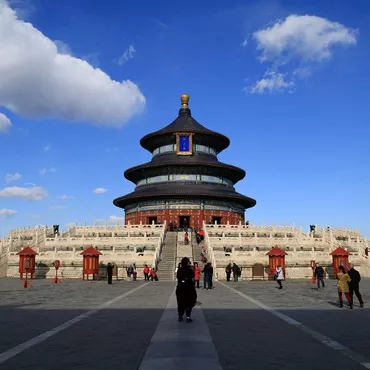Beijing Bell and Drum Towers
The Bell Tower and Drum Tower of Beijing, collectively known as the "Beijing Bell and Drum Towers," stand as venerable timekeepers in the heart of Beijing's Dongcheng District, at No. 9 Zhonglouwan Street. These architectural marvels have served as pivotal timekeeping centers across three dynasties—Yuan, Ming, and Qing—each era leaving its indelible mark on their construction and significance.
The origins of these towers trace back to the Yuan Dynasty's reign in 1272, a testament to ancient craftsmanship and engineering foresight. Rebuilt during the Ming Dynasty's Yongle Emperor's reign in 1420, and subsequently refurbished in 1539 during the Jiajing Emperor's era, the Drum Tower and Bell Tower have endured as architectural icons through the Qing Dynasty's Qianlong Emperor's restoration efforts in 1745.
Situated along Beijing's central axis, these towers are not mere structures; they embody the soul of imperial timekeeping and architectural grandeur. The Beijing Drum Tower, painted in a resplendent crimson hue, rises majestically with its two-tiered design soaring 46.7 meters into the heavens. Facing south with a footprint spanning approximately 7,000 square meters, its elegant grey-tiled roofs adorned with emerald-green glazed edges exemplify the intricate triple-eave wooden structure. Within, the echoes of history resonate with the presence of 25 magnificent ancient drums, each a testament to the rhythm of ancient Beijing.
Across the square, the Bell Tower stands in serene contrast, its grey-brick facade reaching 47.9 meters high. Mirroring its counterpart to the south, this architectural gem covers approximately 6,000 square meters. Crowned by a graceful double-eaved hip roof, it shelters within its walls an octagonal wooden frame for the historic bronze bells, a priceless collection of cultural artifacts that have marked the passage of time for centuries.
Recognized for their profound cultural and historical significance, the Beijing Drum and Bell Towers were officially designated as national key cultural relics by the State Council of the People's Republic of China on November 20, 1996. This distinction underscores their pivotal role not just as architectural marvels but as guardians of Beijing's storied past and vibrant cultural legacy.
Beyond their architectural splendor, these towers symbolize the rhythmic heartbeat of Beijing—a city where ancient traditions harmoniously coexist with modern dynamism. Standing sentinel along the central axis, they are not mere monuments but storytellers of a bygone era, narrating tales of emperors and dynasties, of rituals and celebrations echoing through the corridors of time.
Visitors who ascend the steep steps of the Drum Tower are rewarded not only with panoramic views of Beijing's bustling streets but also with a profound sense of connection to its imperial past. Here, amidst the whispering winds and resonating beats of ancient drums, one can almost feel the pulse of history itself—a vibrant tapestry woven with threads of ceremony, innovation, and cultural exchange.
Meanwhile, the Bell Tower beckons with its tranquil presence, offering visitors a serene refuge amidst the city's hustle and bustle. Its tranquil courtyards and meticulously preserved artifacts invite contemplation, inviting guests to pause and reflect on the passage of time and the enduring legacy of Chinese civilization.
As day gives way to night, the Beijing Drum and Bell Towers take on a new persona, illuminated against the darkening sky like beacons of cultural enlightenment. Bathed in the glow of modern lighting, their timeless silhouettes cast shadows that stretch across the centuries, bridging the gap between past and present in a seamless continuum.
The allure of these towers extends beyond their physical presence, captivating the imagination and stirring the soul of all who encounter them. They stand as testament to the ingenuity and artistic prowess of ancient craftsmen, whose dedication to perfection resulted in structures that have withstood the test of time and the ravages of history.
Today, as Beijing continues to evolve as a global metropolis, the Bell and Drum Towers remain steadfast reminders of the city's rich heritage and enduring spirit. They serve not only as cultural landmarks but also as living monuments to the resilience and creativity of the Chinese people—an enduring legacy that continues to inspire and captivate visitors from around the world.
In essence, the Beijing Bell and Drum Towers transcend mere architectural significance; they embody the essence of Beijing itself—a city where tradition meets innovation, and where the echoes of the past resonate harmoniously with the rhythms of the present. They stand as guardians of history, their towers reaching skyward like bridges between antiquity and modernity, inviting all who behold them to embark on a journey through time—a journey illuminated by the timeless allure of China's ancient capital.
















